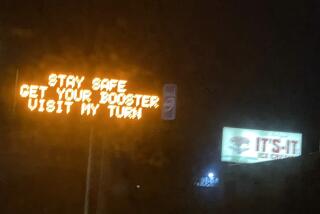Clean Highway Plan Fades as Funds, Interest Dwindle
- Share via
WASHINGTON — Lady Bird Johnson’s pet program to beautify the nation’s highways is losing its luster, a victim of money cutbacks, bureaucratic indifference and a 7-year-old amendment that raised the cost of removing billboards, the government reported today.
The result is that 20 years after Johnson’s tree-planting spree spawned the Highway Beautification Act of 1965, many of the nation’s federally funded interstate highways are still studded with billboards, according to a General Accounting Office report.
In fact, 30,000 new billboards were to be erected legally in 1983 alone, the report said.
Funds Sharply Reduced
The report said that although more than $200 million has been spent on the beautification program since 1965, annual federal expenses declined from about $27 million in fiscal 1976 to about $2 million in fiscal 1984. And at that time, no new money was appropriated.
The Federal Highway Administration estimates that there are 120,000 nonconforming signs across the country that would cost $427 million to remove.
“In many ways, the aims of the act have been perverted by amendments and the influence of the billboard lobbyists,” said Sen. Robert T. Stafford (R-Vt.), chairman of the Senate Environment and Public Works Committee.
Stafford cited a 1978 amendment that requires local and state governments to pay billboard owners in cash for dismantling billboards for reasons other than those mandated by the Highway Beautification Act. The amendment raised the cost of controlling billboard advertisements by increasing the number of signs that cannot be removed without compensation.
“We’ve taken a good law designed to limit the spread of billboard blight and used it as a club to prevent local and state governments from removing billboards considered to be eyesores,” Stafford said.
The GAO report stated that several organizations, including the Garden Clubs of America, the Sierra Club and the National League of Cities, favored repealing the amendment, but that advertising and business organizations opposed repeal.
Matter of Timing
Illegal signs are those erected after the program became effective and are just what they are called: illegal. Nonconforming signs are those that were erected before the program became effective.
The report says that since 1982 the Reagan Administration has not requested the federal funding necessary to remove nonconforming signs.
The GAO report is supported by a recent report by the Transportation Department’s inspector general, Joseph P. Welsch, who said after examining sign-removal programs in the Southeast that the control program “has not significantly improved the aesthetic quality or the recreational value of the region’s primary and interstate highways.”
More to Read
Sign up for Essential California
The most important California stories and recommendations in your inbox every morning.
You may occasionally receive promotional content from the Los Angeles Times.













